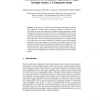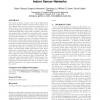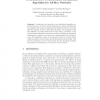IJCAI
2007
14 years 2 months ago
2007
WiFi localization, the task of determining the physical location of a mobile device from wireless signal strengths, has been shown to be an accurate method of indoor and outdoor l...
INFOSCALE
2007
ACM
14 years 2 months ago
2007
ACM
—Due to the proliferation of WiFi access points, indoor localization methods based on WiFi signal strengths are becoming more and more attractive because they don’t require add...
EWSN
2006
Springer
14 years 4 months ago
2006
Springer
The wide availability of radio signal strength attenuation information on wireless radios has received considerable attention as a convenient means of deriving positioning informat...
DCOSS
2006
Springer
14 years 4 months ago
2006
Springer
In this paper, we examine several localization algorithms and evaluate their robustness to attacks where an adversary attenuates or amplifies the signal strength at one or more lan...
MMB
2010
Springer
14 years 4 months ago
2010
Springer
In this paper, we introduce and evaluate CrossTrace, a framework for performing cross-layer measurements in IEEE 802.11 based wireless networks. CrossTrace allows tracing of parame...
IPSN
2010
Springer
14 years 4 months ago
2010
Springer
The robust operation of many sensor network applications depends on deploying relays to ensure wireless coverage. Radio mapping aims to predict network coverage based on a small n...
QOFIS
2004
Springer
14 years 6 months ago
2004
Springer
Abstract. An intention to adopt IP protocol for future mobile communication and subsequent extension of Internet services to the air interface calls for advanced performance modeli...
PERVASIVE
2004
Springer
14 years 6 months ago
2004
Springer
In this paper we introduce a new distributed algorithm for location discovery. It can be used in wireless ad-hoc sensor networks that are equipped with means of measuring the dista...
ICANN
2005
Springer
14 years 6 months ago
2005
Springer
Abstract. We characterize the first hardware implementation of a selforganizing map algorithm based on axon migration. A population of silicon growth cones automatically wires a t...
ICON
2007
IEEE
14 years 7 months ago
2007
IEEE
— Wireless ad hoc networks often require a method for estimating their nodes’ locations. Typically this is achieved by the use of pair-wise measurements between nodes and their...



